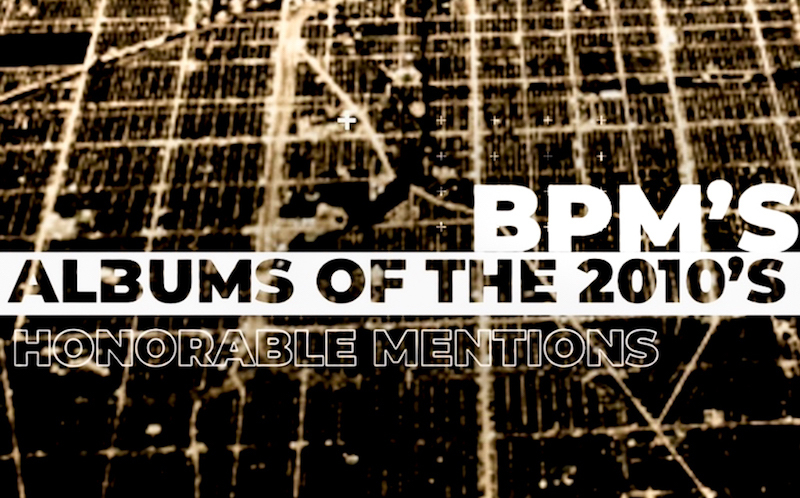This week Beats Per Minute is unveiling its Top 50 albums of the 2010s.
We’re well aware it’s one or two years later than everybody else, but we wanted to take the opportunity to partake in the celebration of what was a truly unique, exciting and transformational 10 years for music.
We also thought that this would be a good opportunity to really express who BPM are, what are the records that our team has cherished over this strange decade, which ones have stayed with them, and which ones inform the artists we seek out and write about today.
Of course, in any populist vote, there are the albums that get sidelined. They just aren’t loved or appreciated by enough people, but they mean the world to individuals – perhaps they love these albums even more because so few people seem to comprehend how spectacular they are.
That’s why we threw the doors open to write about any albums they wanted – as long as they came out in the 2010s – and tell everybody why it is imperative they take the time to seek them out. These are our Honorable Mentions.
We’ve got a final list of 20 records that are no less essential than the Top 50 Albums we’ll be unveiling tomorrow. Make sure you check back in then.
Listen to a Spotify playlist of our favorite songs from our Honorable Mentions

billy woods + Kenny Segal – Hiding Places
[Backwoodz Studioz; 2019]
For some stupid fucking reason the world has slept on billy woods for a long time. It’s infuriating actually, considering just how ridiculous great he is from project to project. Whether he’s working in tandem with Elucid as the experimental hip-hop duo Armand Hammer, or just doing his solo work, woods built a warehouse of incredible material for the whole 2010s. Most of which flew under the radar, naturally.
Early 2019 though, with the help of producer Kenny Segal – who helped both R.A.P. Ferreira and Serengeti drop their two best albums last year – woods released arguably his most thrilling release to date in Hiding Places. woods is an in-your-face conscious rapper, he’s never going to pull his punches, and that’s what Hiding Places does better than most rap albums of the decade. He raps from a confined space on “Spider Hole” taking shots at Nas for pretending to be a man of the people but still charging outlandish prices for a show at Carnegie Hall.
Maybe that’s what it is though. woods isn’t afraid to make people uncomfortable whether it be through his lyrics or his choice of cover art. Hiding Places is woods’ most complete solo work to date, he covers a multitude of subjects and Segal’s production flourishes in ways one wouldn’t expect. There’s jazzy horns on the outro to the chaotic “Speak Gently” and then a very slow-waltz feel to album closer “Red Dust.”
But really, nothing compares to “Spongebob,” the album’s riveting opener. Naming it off of the popular Nickelodeon character is no coincidence, as woods finds a connection to those days of youthful innocence and the state of world affairs. As with any work from woods, sleuthing may be needed to understand his weighty verses. It’s what helps him stand out from the normal bravado of hip-hop, as he’d rather his listener be informed than like his music. – Tim Sentz

black midi – Schlagenheim
[Rough Trade; 2019]
black midi followed a similar rise to fame as did their fellow countrymen Arctic Monkeys — the music community found out about them via the internet prior to having any material released, and word spread like wildfire. Although their noisy style with complex rhythms did not seem to have great potential for popularity, it turned out to be quite the opposite. While the genre black midi could be placed under is somewhere between math rock, jazz and noise rock, the Londoners proved to be able to combine these into some of the grooviest (and at times even catchiest) tunes of the 2010s.
Schlagenheim is one of the only albums of the past decade that can be genuinely described as ‘controlled chaos’. Almost all the tracks manage to jump from calm and quiet to insanely energetic and abrasive so rapidly that it makes one think ‘this should not work’. But it does.
black midi’s debut album was destined to be a sensation from the start, or rather, since their KEXP performance. Prior to that appearance, the band could only be heard on poor quality bootleg recordings. Schlagenheim not only amounted to the hype that it gained prior to its release, but surpassed it by so much that it almost single-handedly directed lots of attention at that particular scene of indie music, which led to the rise of such names as Black Country, New Road and Squid.
Guitar-based music has been suffering from the lack of development and experimentation or popularity over the past decade at least; acts that focus on wide appeal tend to sound secondary to quite a lot of their predecessors, whereas bands that aim to create something esoteric tend to be lost to obscurity. black midi on Schlagenheim ‘showed us how it’s done’ – that is, how guitar-based music in the (rather late) 2010s can be fresh, interesting and innovative, while at the same time so groovy and memorable that even listeners who do not necessarily gravitate towards rock music may find Schlagenheim worth their attention. – Aleksandr Smirnov
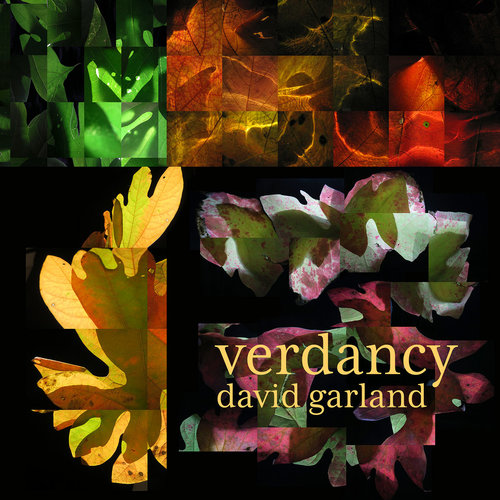
David Garland – Verdancy
[Tall Owl Audio; 2018]
My mind goes on the defensive seeing an album over four hours long. “Is it a studio album box set? Decades of demos?” Nope, nope. “A live drone set? Algorithmic generation?” None of those. There has to be a trick here. The fear sets in as I realize I’m dealing with a behemoth. Four hours of lovingly crafted, ornately arranged music. And as a bonus, it’s impossible to attach a genre label to.
And since I’ve heard it, I’ve gone on a personal mission to evangelize it.
There is a drone-like heart to David Garland‘sVerdancy in its key instrument: a 12-string acoustic guitar that his son Kenji modified to produce a sustained organic rumbling. The effect sounds strangely ‘alive’ and intimate – there is very little electronic processing or reverb on the album. Now take this ‘drone’ and create an arrangement for it like something out of a 2000s Sufjan Stevens album. Verdancy is equally comfortable tuning out to a stretch of lush peaceful instrumentals before reeling back into traditional songwriting, lovingly treating both with an equal attention to detail.
The ambition is hard to overstate: David lists over 20 instruments he plays himself (including ocarina, harmonium, and bowed psaltery), and that’s before getting to collaborators. There are lyrics in Czech, Italian, and Latin, even lyrics from personal friend Yoko Ono.
Naturally there is a lot in these four hours to unpack. The best argument against Verdancy being daunting is Verdancy itself. The variety, density, and sheer size melt away in service to its peaceful, organic, welcoming aura. It is delightful in its surprises, such as the moody synthesizers and tension of “Dream Home” giving way to a joyous singalong, or the healing and stunning 22-minute build of “Lux Temporalis”. The size is only proper as an ode to the lofty things like trees, wind, gentleness and tranquility itself. It may not be recognized as a masterpiece yet, but an artistic creation of this magnitude can only go on overlooked for so long – Josh Sand
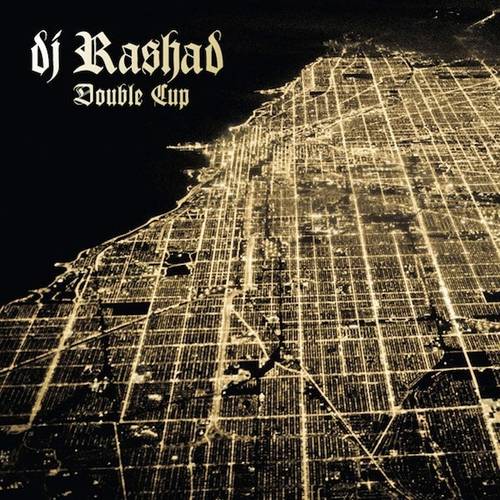
DJ Rashad – Double Cup
[Hyperdub; 2013]
Footwork’s first essential LP, Double Cup is a marker for the genre and its most important artist, the late DJ Rashad. The quintessentially Chicago sound was given a national platform with a record that is remarkably consistent for electronic music, which typically fares best on singles and EPs.
Instead, Rashad’s vision of grooves that took the geometry of trap and crunk and spun them into something beyond the math of hip hop.
Songs like “She a Go” and “Pass That Shit” sound like classics on first listen, and they’re still party starters. It’s easy to ask what else Rashad might have done if he’d had the time, but we’re blessed to even have Double Cup, an album we’re still reaping rewards from. – Ben Cohn
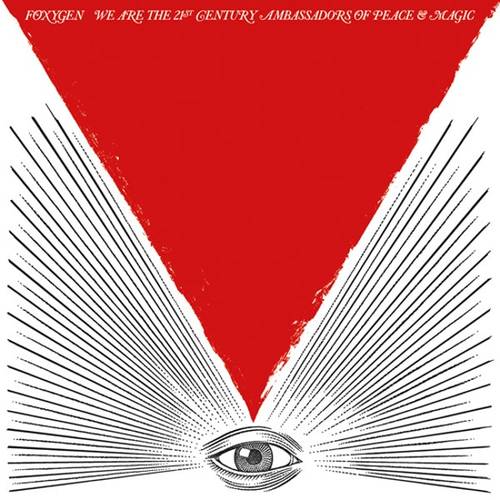
Foxygen – We Are The 21st Century Ambassadors of Peace & Magic
[Jagjaguwar; 2013]
A couple of months ago music journalist Andrew Male posted a photo of Foxygen‘s second (well, third if you count the download-only indulgence Jurrassic Exxplosion Phillipic) LP on Twitter, saying that when it first came out he “dismissed it as derivative psychedelic pastiche. Now it’s just old and in the past like everything else. It sounds great.” This hindsight revelation (along with the band’s considerably bumpy career) is probably what made for the album’s divisive public status: you either forgot about it altogether, or you fell hopelessly and forever in love with it.
Truth is, We Are… gathers hit after hit after hit in a way that is simultaneously fresh and referential – remember the “Under My Thumb” riff on “On Blue Mountain”, or the Reed-meets-Dylan vocals on “No Destruction”? – propelling us towards a loop re-visitation of the past through the restless minds of surdoués Sam France and Jonathan Rado, guided by the late great Richard Swift.
We Are… is so incredibly foundational that it’s not an overstatement to say it was one of the main albums initiating and publicising the early 2010s neo-psychedelia craze; but it’s also the doom and despair evoked at the end of the title-track that along with “San Francisco”‘s more or less discrete cynicism regarding this same revival prophesied its rapid decline. – Ana Leorne

Inter Arma – Sky Burial
[Relapse; 2013]
The Richmond, VA metal act Inter Arma had a fairly innocuous start to the decade with 2010’s Sundown, a record that’s considerably rougher in sound and approach than the lusher, more psychedelic and progressive work that was to come. Nevertheless, the record showed promise, and it already established Inter Arma as a group that was capable of cherry-picking and recontextualising stylistic touchstones from any number of underground metal’s sub-genres, thereby making themselves incredibly difficult to pin down.
2013’s Sky Burial didn’t make this particular task any easier, as it incorporated even more varied styles to match the band’s growing ambitions. Sky Burial is the group’s first irrefutable classic. It’s a fantastical journey of a record, one which ebbs and flows with such precise dynamic control that it positively flies by despite its imposing runtime.
Even on just their sophomore record, Inter Arma had struck upon a sound that seemed to redefine the notion of heaviness. The guitar and bass tones are simply immense, and T.J. Childers’ drumming could level buildings. Beyond the pure sound of the thing, the album is rich with emotionally searing drama, not least on the standout track, “The Long Road Home”; a slow-building epic with a black metal crescendo that sounds surprising each time it screeches out of the speakers.
The sheer creativity, peerless musicianship, visceral power and memorable songwriting on display on Sky Burial all conspire to make Inter Arma a uniquely devastating proposition. Listening to this masterwork will make you feel like you’ve died a violently heroic death on a blood-splattered battlefield, and ascended to Valhalla. – Andy Johnston

Julia Holter – Loud City Song
[Domino; 2013]
Loud City Song is Julia Holter’s most complete work to date. She may have captured hearts with the intoxicating weirdness of Ekstasis, gone on to write her most gorgeously accessible songs on Have You In My Wilderness, and dived head-first into decadent experimentation on the double album Aviary – all of which are absolutely wonderful – but Loud City Song is the one that draws me back again and again.
On her third album, Holter presents a set of songs that both expand outward to encompass the world and fold inwards to her fantastical imagination. The whole thing feels like a psychogeographical exploration of Holter’s mindset, set to resplendent arrangements of upright bass, synths, horns and strings that animate these excursions with fluid, real-time movement.
Perhaps the most immediately infectious of the bunch are the more psychedelic ventures inwards. “Horns Surrounding Me” genuinely does feel like a gaggle of disembodied instruments flitting around the singer, who frolics with them in what could be the perfect song for to get a Fantasia reboot green-lit. Or perhaps that would be “In The Green Wild”, where, with a hop, skip and a jump, we plummet with Holter into the wild wonderland, where she dances with flowers and laughs with trees – a scene perfectly painted by the sprightly arrangement.
However, the majority of Loud City Song is exactly what its title suggests: an exploration of the bustle of the city and what it feels like to be swallowed by its sound and movement. Although, this might not necessarily be a modern city. From the opening “World” there is a feeling of eyes being opened to a city steadily growing busier, while twin tracks “Maxim’s I” and “Maxim’s II” transport us back to the mid-20th century when cities were just starting to huff, clang and screech like modern day metropolises, and the inhabitants were doing much the same.
Between these pressures of new high society, Holter also displays wistful desires for a loving connection in songs like her stunning cover of Barbara Lewis’ “Hello Stranger” and the deeply reflective “He’s Running Through My Eyes”. By the final “City Appearing”, we feel like we’re with her, looking back on her last few years of adaptation, growing up alongside the booming cityscape, and there’s a sublime satisfaction at having made it, head held high. – Rob Hakimian
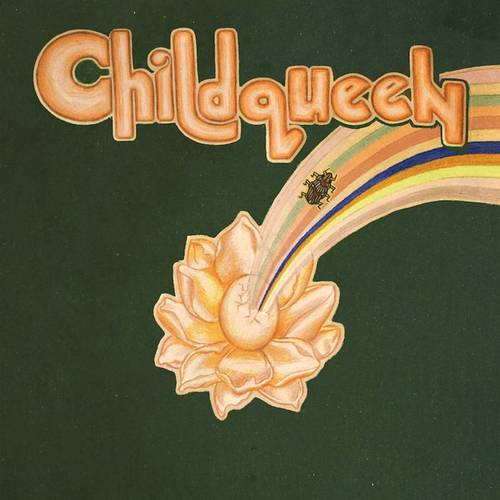
Kadhja Bonet – Childqueen
[Fat Possum; 2018]
Every once in a while the stars align for the birthing of a unique album that is so inherently magical you even wonder if it’s real or if it’s an unverifiable UFO sighting. Kadhja Bonet‘s Childqueen embodies this perfectly, especially since it seems to have slipped simultaneously under and over the radar (“a bird? A plane? Superman? Did you even catch it?”). Whenever you casually mention the album in conversation, people are either completely oblivious to its existence (a prayer for those who haven’t seen the light yet) or utterly head over heels about it.
The mystic revelation first came with first single “Mother Maybe”, which blended old school soul and funk (some may swear they can hear Minnie Riperton’s ghost hovering around the room) in what felt like both a continuation of 2016’s The Visitor and a whole new dimension altogether. But it’s really the heightened state of conscious Bonet achieves with the whole thing – through “Delphine”, “Another Time Lover”, “Joy”, “Procession” – that turns it into an exhilarating celebration of power and surrender, attachment and release, glory and darkness: Childqueen is a binding spell in audio form. – Ana Leorne

Kaizers Orchestra – Violeta Violeta Vol. III
[Kaizerecords; 2012]
Ideally this would be a couple hundred words about all three versions of Violeta Violeta, but it’s hard to deny thatVol. III stands so much taller than its two predecessors. The Stavanger Symphony Orchestra utilized fully across the majority of the album’s 10 stunning tracks add a grandeur that all artists wish they could bow out and retire on like Norway’s Kaizers Orchestra did.
A cinematic spectacle full of enchantment, excitement, and undeniable electricity, not a moment is wasted: the sudden death metal burst on “Satan i halsen” amidst the marching wooden percussion and Morricone brass; the middle Eastern flourishes of “Markedet bestemmer”; and demented accelerating Yiddish-tinged carnival finale of “Det polaroide liv”where the guitars, trumpets, and strings swirl into a thrilling vortex. Lead singer and songwriter (and if you saw him live for the album’s accompanying tours, tapdancer also) Janove Ottesen is on career-high form; his summoning and smooth “thank you, thank you” on the album’s opening track “Begravelsespolka” sets the tone: a performance has begun.
Even the album’s serene moments sink their way into your head, and somehow manage to build on each other. “Perfekt i en drøm” would be a perfectly fine ending point, with its settling bed of organ and choral accompaniments, but “Sekskløver” somehow manages to find an even more beautiful moment to send the album off on.
When Kaizers Orchestra arrived on the scene with their oil drum-laden debut album Ompa til du dør back in 2001, it would have been easy to predict diminishing returns over the years. Aside from a slight lull in quality after Maestro, the band kept managing to outdo themselves. And with Violeta Violeta Vol. III they managed to completely outdo any expectations – even those built up from the previous two instalments of the trilogy; building on the thrills of their previous early releases while also weaving an operatic narrative that gets a Wagnerian conclusion – complete with what sounds like a cannon fire on the final track. Like they exploded onto the scene back in 2011, they exploded out of it with this phenomenal album. – Ray Finlayson

[Hyperdub; 2017]
Laurel Halo – Dust
Dust plays like Laurel Halo’s surrealist take on modern pop. The tropical bongo groove on “Moontalk” could underpin Drake’s recent anonymous ‘global’ explorations, but instead of a gnawing hook, we get landline sounds, singing in Japanese, and creepy laughing panned left and right so hard your head will spin. Or on “Jelly,” a queasy vocal line, auto-tuned out of key and offbeat leads us across an odyssey of sounds, with Klein even lending a pseudo-rap verse.
Halo’s diverse influences, from musique concrete to nu-jazz all show up here, refracted through the unparalleled mind of weirdo. Nothing sounded like Dust in the 2010s, and nothing still does. – Ben Cohn

